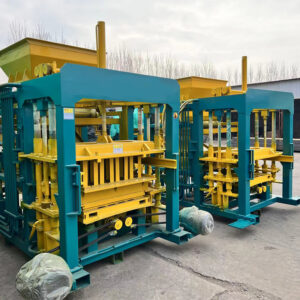
Image source :Aiweiblockmachine
Eco-Friendly Materials Drive Demand for Advanced Brick Making Equipment”
Introduction
In an era marked by increasing environmental consciousness, the construction industry is undergoing a transformative shift towards sustainability. As concerns about carbon emissions, resource depletion, and ecological impact grow, construction materials play a pivotal role in shaping the industry’s ecological footprint. Among these materials, bricks – a cornerstone of construction for millennia – are now being reimagined through the lens of eco-friendliness. This article delves into how the demand for advanced brick making equipment is being driven by the adoption of eco-friendly materials, reshaping construction practices and paving the way for a greener future.
- The Environmental Imperative in ConstructionThe construction industry has traditionally been associated with significant environmental impacts, including high energy consumption, raw material extraction, and waste generation. As society becomes more environmentally aware, there is a growing demand for sustainable alternatives that minimize these negative effects. Eco-friendly construction materials have emerged as a key solution to address these concerns.
- Redefining Bricks: From Traditional to Eco-Friendly2.1 Conventional Brick Making
Conventional brick making relies on resource-intensive practices, including clay extraction, firing in high-temperature kilns, and extensive transportation. These processes contribute to greenhouse gas emissions, soil degradation, and air pollution.
2.2 Eco-Friendly Brick Making
Eco-friendly brick making seeks to minimize the ecological impact of brick production by utilizing alternative materials, innovative manufacturing techniques, and energy-efficient processes. These approaches aim to reduce carbon emissions, conserve natural resources, and promote sustainable construction practices.
- Innovative Eco-Friendly Materials for Bricks3.1 Fly Ash Bricks
Byproduct from coal combustion, fly ash can be incorporated into brick manufacturing, reducing the need for traditional clay. These bricks offer comparable strength and durability while diverting a waste product from landfills.
3.2 Recycled Bricks
Recycled materials, such as crushed glass, construction and demolition waste, and plastic, can be incorporated into brick production, reducing the demand for virgin resources and promoting circular economy principles.
3.3 Hempcrete Bricks
Hempcrete, a mixture of hemp fibers and a lime-based binder, creates lightweight and insulating bricks. This renewable material sequesters carbon dioxide during growth and offers excellent thermal properties.
3.4 Biodegradable Bricks
Innovative research explores biodegradable materials like mycelium, a fungus-based substance, for brick making. These bricks can decompose naturally at the end of their lifecycle, reducing waste.
- The Role of Advanced Brick Making Equipment4.1 Automated Mixing and Production
Advanced brick making equipment facilitates precise mixing of eco-friendly materials, ensuring consistent quality and reducing waste. Automation streamlines the production process, optimizing resource utilization.
4.2 Energy-Efficient Kilns
Kilns with improved insulation and energy-efficient design contribute to lower carbon emissions during firing, a critical phase in brick manufacturing. Renewable energy sources can further enhance sustainability.
4.3 Customization and Design Flexibility
Advanced equipment enables manufacturers to experiment with various eco-friendly materials and create innovative brick designs. This customization supports architectural creativity while adhering to sustainable principles.
- Market Dynamics and Economic Incentives5.1 Consumer Demand and Green Building Standards
The growing consumer preference for sustainable construction, coupled with the rise of green building certifications, drives the adoption of eco-friendly materials and advanced brick making equipment.
5.2 Regulatory Support
Government policies that encourage sustainable practices, offer incentives for eco-friendly construction materials, and impose stricter environmental regulations are propelling the demand for greener bricks.
- Challenges and Future Outlook6.1 Cost Considerations
While eco-friendly materials offer long-term benefits, initial investment costs for advanced brick making equipment and sustainable materials can be higher. However, economies of scale and increased demand are gradually reducing these barriers.
6.2 Material Standardization and Testing
Ensuring consistent quality and performance of eco-friendly bricks requires rigorous testing and standardization. Collaborative efforts between manufacturers, researchers, and regulatory bodies are essential.
6.3 Education and Awareness
Promoting the benefits of eco-friendly materials and advanced brick making equipment among architects, builders, and consumers is crucial for driving widespread adoption and changing industry norms.
- Case Studies: Successful Implementation of Eco-Friendly Brick Making7.1 The Netherlands’ Sustainable Brick Manufacturing
The Netherlands has embraced sustainable brick making practices, incorporating recycled and bio-based materials into brick production to align with the country’s stringent environmental goals.
7.2 Australia’s Green Building Revolution
Australia’s construction industry has witnessed a surge in demand for eco-friendly bricks, driven by consumer demand and government incentives promoting sustainable construction.
- ConclusionThe construction industry stands at a pivotal juncture, compelled by environmental imperatives to embrace more sustainable practices. The integration of eco-friendly materials through advanced brick making equipment is a testament to this transformative shift. As demand for greener construction materials grows, manufacturers, regulators, and stakeholders must collaborate to drive innovation, promote sustainability, and build a more eco-conscious future for the built environment.
https://youtu.be/BLtJK_hVxDo
